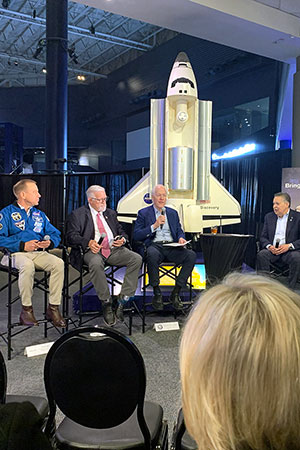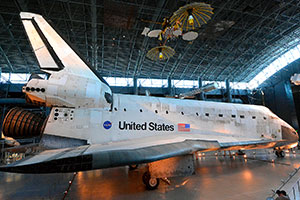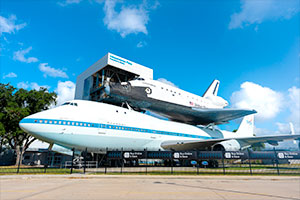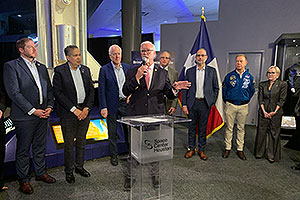June 30, 2025 — A political effort to relocate the space shuttle Discovery from the Smithsonian to Space Center Houston has been merged with the so-called "One Big Beautiful Bill," a major economic and policy package now nearing a vote in the U.S. Senate.
Update for July 1 at 12:30 p.m. EDT: The Senate passed the One Big Beautiful Bill Act with the provision to relocate space shuttle Discovery included with a vote of 50 to 50, and Vice President JD Vance breaking the tie. The bill now heads to the House of Representatives.
Update for July 3 at 1:40 p.m. EDT: The House has passed he Senate version of the bill with a vote of 218 to 214. It now heads to the President for his signature.
Update for July 4 at 6:15 p.m. EDT: The President signed the bill into law during a ceremony on the White House South Lawn on Independence Day.
The "Bring the Space Shuttle Home Act" first introduced by Texas Senators Ted Cruz and John Cornyn in April has now been added to the Senate's version of the bill championed by President Donald Trump. While the latter legislation primarily focuses on tax cuts and spending increases, the Senate Committee on Commerce, Science & Transportation, chaired by Cruz, added the retired orbiter's relocation as part of an additional $9.995 billion in funding for NASA's programs, including the return of astronauts to the moon and sending humans to Mars.
"One of the things in the in the Big Beautiful Bill we're talking about, there's about a $10 billion appropriation for NASA," said Cornyn at a June 20 press conference at Space Center Houston. "We're optimistic that bill that started out as a beautiful bill in the House will become even more beautiful in the Senate this week."
Out of that appropriations, $85 million is directed to carry out Cornyn's Bring the Space Shuttle Home Act, which calls for Discovery to be removed from its home of the past 13 years, the National Air and Space Museum's Steven F. Udvar-Hazy Center in Chantilly, Virginia, and put it on display at Space Center Houston, the official visitor complex for NASA's Johnson Space Center in Texas.
The Senate version of the One Big Beautiful Bill provides "no less than $5 million" for the "transportation of the space vehicle'' and the remainder to go towards the construction of a facility to house it.
Is $85 million even enough?
The original text of the Bring the Space Shuttle Home Act called for the NASA Administrator and the Smithsonian to jointly develop a plan for moving Discovery prior to appropriations being made by Congress. It is unclear if even the total amount allocated by the Senate would be enough; the National Air and Space Museum provided Congress with an estimate of $200 to $300 million for the move, according to the Houston Business Journal.
Others have pegged the cost between $5 million to upwards of $1 billion. In 2012, when NASA's three retired orbiters and the prototype Enterprise were being moved to their current museum homes, each institution was responsible for paying $28.8 million for the preparation and transportation of the orbiter (a reduction from the $42 million that was first estimated).
Congress waived the fee for the Smithsonian after the National Air and Space Museum said that its budget would not cover Discovery's delivery. "Should the [NASA] Administrator determine that the Smithsonian Institution is an appropriate venue for an orbiter, such orbiter shall be made available to the Smithsonian at no or nominal cost," read the provision.
Cornyn said that the benefits of displaying Discovery in Houston — including economic and educational considerations for the local area — outweighed the prior actions that Congress has taken to support having NASA's most-flown spacecraft amongst the national collection.
"There's no question the Smithsonian is a national treasure, but it doesn't hold all the treasures that America has to show," said Cornyn, replying to a question from collectSPACE at the Space Center Houston briefing. "It would be nice if there were more to go around, but since there are only four, we are going to get the one that we should have gotten back in 2010."
In 2011, the NASA Office of the Inspector General investigated the process that NASA went through and found "no evidence that the White House, politics or any other outside force improperly influenced the selection decision." The OIG did find one "significant error," but it would have benefited the National Museum of the U.S. Air Force in Ohio, rather than Space Center Houston.
Don't say Discovery
The language in the Senate bill avoids any mention of the Smithsonian, Space Center Houston, Discovery or even the space shuttle. It only stipulates that a "space vehicle" (defined as a vessel that carried people into space) be transferred within 18 months of enactment to a NASA center "involved in the administration of the Commercial Crew program" and put on public display "within the Metropolitan Statistical Area" of that center.
The bill directs that the NASA administrator (or acting administrator) identify the vehicle within 30 days of the bill becoming law. Of the four retired orbiters, Enterprise in New York and Endeavour in California are owned by their display homes; Discovery and Atlantis, the latter on display in Florida, remain federal property.
The vagueness of the wording is an effort to avoid the provision being flagged by the Senate parliamentarian for violating the "Byrd rule,'' which keeps "extraneous matter" out of Senate reconciliation bills, including earmarks directed at a specific recipient, according to Roll Call. The shuttle move as originally phrased was identified at being at risk.
Should the text remain and make it to a vote and the Senate passes the bill, then it still must return to the House of Representatives to be reconciled with its version passed in May. Rep. Randy Weber, serving Texas' 14th District, said that he was prepared to enter Discovery's move into the House bill.
"We're working on it," said Weber at Space Center Houston, standing with Cornyn. "They are working on the Big Beautiful Bill, we'll get this done and hopefully, we'll get this headed our way." |
|

Senator John Cornyn (at center) speaks about the "Bring the Space Shuttle Home Act," an effort to move the space shuttle Discovery, at a press conference at Space Center Houston on June 20, 2025. Joining Cornyn at the event were former astronaut Tim Kopra, Rep. Randy Weber (TX-14), Space Center Houston CEO William Harris and Brian Freedman, president of the Bay Area Houston Economic Partnership. (collectSPACE)

NASA's retired space shuttle Discovery as seen on display in the McDonnell Space Hangar at the Smithsonian National Air and Space Museum's Steven F. Udvar-Hazy Center. (collectSPACE)

NASA's first Shuttle Carrier Aircraft NASA 905 and the mock orbiter Independence at Space Center Houston. (Space Center Houston)

Representative Randy Weber speaks at a press conference about the "Bring the Space Shuttle Home Act" at Space Center Houston on Friday, June 20, 2025. (collectSPACE) |
